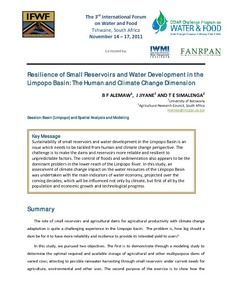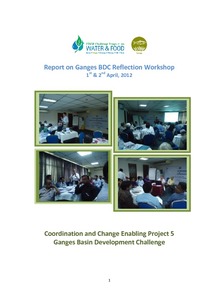Research contribution to the World Water Vision
A summary of IWMI's research contribution to the Vision process. Topics include: global water scarcity, the productivity of water, water storage, groundwater, and poverty, gender and water.
Report on Conflict Analysis and Power Relations in Pursat Catchment
The MK16 report analyses stakeholder roles, relationships, and views on water resources management in Cambodia in general, and Pursat specifically, for developing good IWRM structures that incorporates a shared understanding of the reality and complexity of different stakeholder interests and relationships. The analysis is designed to examine the degree of consistency or disparity between different stakeholders, and between formal stakeholder roles and actual practices.The Conflict/Difference and Power Relation Analysis in Pursat Catchment addresses the following research questions:
Resilience of small reservoirs and water development in the Limpopo Basin: The human and climate change dimension
Responding to global challenges in food, energy, environment and water: risks and options assessment for decision-making
We analyse the threats of global environmental change, as they relate to food security. First, we review three discourses: (i) ‘sustainable intensification’, or the increase of food supplies without compromising food producing inputs, such as soils and water; (ii) the ‘nexus’ that seeks to understand links across food, energy, environment and water systems; and (iii) ‘resilience thinking’ that focuses on how to ensure the critical capacities of food, energy and water systems are maintained in the presence of uncertainties and threats.
Report on Ganges BDC Reflection Workshop
Phase II of the CGIAR Challenge Program for Water and Food (CPWF) is a multi-institutional and inter-disciplinary research for development initiative focused on increasing the resilience of social and ecological systems through better water management for food production.Phase II in the Ganges Basin began in 2011 and is scheduled to end in 2014.
Runoff estimation and water management for the Holetta river in Ethiopia
The hydrology of Holetta River and its seasonal variability is not fully studied. In addition to this, due to scarcity of the available surface water and increase in water demand for irrigation, the major users of the river are facing a challenge to allocate the available water. Therefore, the aim of this research was to investigate the water availability of Holetta River and to study the water management in the catchment. Soil and Water Assessment Tool (SWAT) modelled the rainfall runoff process of the catchment.
Review paper on ‘Garden Kits’ in Africa: lessons learned and the potential of improved water management
The purpose of this paper is to synthesize the available knowledge and lessons learned from past experiences in promoting kitchen or home gardens for food production, with a special emphasis on water management. The benefits of home gardens for better family nutrition, health status of children and mothers, and as an entry point for empowering women have been documented in some studies. However, there is very little specific evidence to confirm these benefits. The paper also reviews some of the water management practices and garden technologies used in home and market gardens.
River management, landuse change, and future flood risk in China's Poyang Lake region
Poyang Lake is the largest freshwater lake in China covering 3800 km2 during the summer wet season. It drains into the Changjiang (Yangtze River) at its northern end through a narrow outlet. During the last half of the twentieth century (1949–1999) average annual maximum stage and number of severe flood events in China's Poyang Lake region increased significantly. There are two primary causes for this trend. One was increasing Changjiang stage, which is the most important determinant of Poyang Lake stage.






